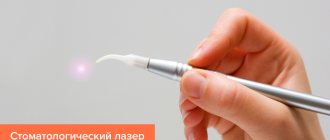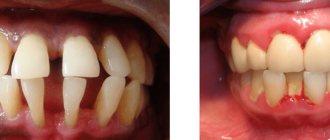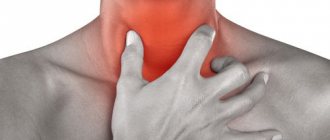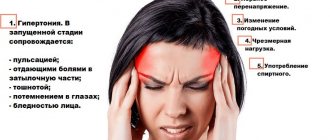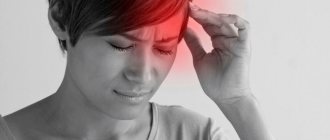Headaches and severe eye pain may indicate a serious problem and ongoing illness. Pain receptors can be located in veins, blood vessels, and the lining of the brain. Therefore, it may seem that the head hurts on one side.
Painful sensations affect the eyes. Most often, the causes of pain on the right side can be from mechanical damage or migraine , in rare cases - tumors and malignant formations .
Attention! If the discomfort is very strong, you should consult a specialist and undergo an examination. After all, any, even minor, pain indicates a problem.
Causes of pain on the right side of the head and eyes
Of the main reasons, several main ones can be identified, but it is worth remembering that prolonged headache discomfort cannot be ignored, especially when it causes severe discomfort.
Main reasons:
- Severe fatigue and overstrain . Discomfort in the head, sometimes strong pulsation and discomfort in the eyes. May occur due to working at a computer or TV. This condition usually occurs in the morning or evening, and is accompanied by tingling in the temples and forehead.
- Various bruises ( blows, concussion ). Even a small blow can cause a concussion and further development of brain diseases.
- Eye diseases (glaucoma). Maybe in one eye, which causes a lot of discomfort. They usually cause the eye to tingle and become blurry.
- Incorrectly fitted glasses or contact lenses. If there is discomfort in one or both eyes, it can cause migraines, tearing and fatigue.
- Spasms of blood vessels . As a result of improperly performed physical exercises, a clamp or damage to a blood vessel can be created in the cervical spine. This will further cause discomfort in the head on the right side, as well as small hemorrhages, which cause migraines and discomfort on the right side. But at the same time, the patient feels nausea, lethargy, and inability to concentrate.
- Very often, athletes suffering from osteochondrosis suffer from headaches, as well as dizziness, neck discomfort, and pain in the eyes. Such symptoms can occur on the right or left, periodically weakening and intensifying.
Brain tumors, meningitis, pre-stroke conditions, and intracranial hematoma are also possible causes of discomfort.
Painful sensations from tumors do not depend on its size, but in addition to unpleasant sensations in the head on the right side, the patient:
- loses weight quickly,
- suffers from seizures
- In the morning the patient may feel nauseous.
Keep in mind! Migraines can occur in people between 25 and 45 years of age. In this case, the discomfort is reflected in one part of the head, affecting pain in the eyes.
This may cause a cramp or slight tingling in the limbs.
Migraines include a serious disease called hemicrania, which often affects women. The discomfort from such a disease is very strong, and externally, the pupils of the eyes become very narrow, and the eyes themselves become very red.
Pain in the right side of the head and right eye can also hurt due to an eye injury, as well as due to
an infectious disease .
And also for colds and breathing problems. If the vessels are damaged, a person who complains of discomfort on the right side of the head may also report pain under the right eye.
Possible reasons
Tingling under the eye may be a symptom of one of the following conditions::
- Sinusitis . The pathology is an inflammation of the nasal sinuses, which communicate with the lacrimal canals. With this disease, the maxillary sinuses, which are located under the eye sockets, become clogged with purulent discharge. The pathology in its advanced form can progress to the chronic stage, and inflammatory processes can spread to the upper respiratory tract. Treatment in this case is carried out by an otolaryngologist, who prescribes appropriate anti-inflammatory and, if necessary, antibacterial drugs.
- Osteomyelitis . A purulent-necrotic process in the bones, which can develop against the background of complications of dental diseases, when infectious processes from the teeth of the upper jaw spread to the infraorbital bones. Treatment consists of taking immunostimulating and antibacterial drugs, vitamins, and in severe cases, blood plasma transfusion to detoxify the body.
- Mechanical damage to the periocular area. Painful sensations in such cases require, first of all, symptomatic treatment and the use of painkillers. And with concomitant damage to the eyeball and penetrating wounds, antibacterial treatment and surgical intervention are necessary.
- Neuralgic pathologies. Such disorders are usually accompanied by a complex of symptoms, including disturbances in facial expressions, numbness of the facial, hypoglossal and pharyngeal nerves. Often the patient experiences tingling sensations in the temples, shoulders or neck.
- Disturbances in the activity of the vascular system of the organs of vision . In such cases, the patient may feel pain in the bone under the eye, but this syndrome only affects the blood vessels and soft tissues.
Only a specialist can determine what exactly causes such a symptom after conducting an appropriate examination.
Treatment is determined solely by the origin of the pathology and its severity.
Treatment
It is worth noting! Before starting treatment for a headache, you need to undergo an examination by a specialist to identify possible causes of this condition on the right side of the head. To do this you need:
- Take an extensive blood test (such an analysis will show all possible deviations from the norm and the causes of frequent discomfort).
- Get a CT scan (CT scans can detect tumors or blood vessel problems).
- Get examined by an ophthalmologist . Even if you don't have vision problems.
Based on the test results and tomography data, the doctor will be able to prescribe treatment. If the pain continues for a short time, you can take painkillers .
Analgin, Spazmalgon, Citramon relieve pain well.
All these tablets quickly dilate blood vessels, eliminate spasms and pain.
If a person has a severe migraine , which creates severe pain on the right side of the head, then doctors recommend taking anti-inflammatory drugs .
Diagnostic methods
It is worth noting! The exact cause of pain can only be determined after a detailed examination, including:
- donating blood for general and biochemical tests;
- rhinoscopy (examination of the nasal cavity);
- nasal swab to analyze the discharge for the presence of pathogenic microorganisms;
- CT scan;
- radiography of the upper jaw area;
- dacryocystography (examination of the tear ducts using x-rays);
- puncture of the maxillary sinus (if sinusitis is suspected).
Prevention measures
To avoid headaches and the causes that provoke them, you need to use the following preventive measures:
- rest and exercise;
- good sleep and frequent walks in the fresh air ;
- complete rest for the eyes ;
- proper nutrition , eating fresh vegetables and fruits;
- drink a lot of water , which saturates with oxygen and improves blood quality.
Massage, sauna, and going to the pool also have a very . These simple recommendations can be followed by every person.
Stay up to date! If you are faced with a migraine or headache, you can take a painkiller, but if the symptoms still do not go away, you need to seek help.
Symptoms of pain under the eye
Note! Painful sensations in the infraorbital area are often perceived as pain in the bone, but in most cases (excluding traumatic ones) soft tissues hurt.
Depending on the disease, tingling may vary in nature and intensity. Most often, such sensations are caused by the development of sinusitis in the acute stage.
In this case, the aches are felt even without pressure, and symptoms such as:
How else can you help yourself with these symptoms?
If you are at home, a good option would be to take a bath with pine needles or sea salt .
It is also important to try tracking your pain for two or three days. Pay attention to changes in the nature of the pain, at what time it occurs and where exactly.
If a symptom occurs on the right side of the head, the pain may occur due to an incorrect position during sleep , an incorrectly chosen and uncomfortable pillow.
And sometimes simply because of the bad habit of sitting with your head bowed for a long time , for example, at work. Eliminate these and similar, at first glance, unobvious factors, and if this is the case, then everything will soon pass.
Dental problems
Another cause of jaw problems can be pathologies in the oral cavity:
- Caries in the middle and deep stages. Without timely treatment, tooth decay exposes the pulp (dental nerve), causing inflammation. This leads to swelling, pain and spasms in the gum tissue.
- Mechanical injury. Dislocation, impact, damage to the dentofacial apparatus also provoke spasms of the facial muscles.
- Eights. Growing wisdom teeth can cause a lot of trouble for the patient, including problems with the cheekbones.
Regular preventive examinations at the dentist - once every six months - will help eliminate the risk of jaw reduction. It would be a good idea to visit an otolaryngologist in case of inflammation in the ears. And a maxillofacial surgeon if there are jaw injuries.
Important: sudden and unexplained contraction of the cheekbones can signal more serious illnesses. This is one of the signs of a stroke, heart attack or angina. In this case, you must immediately call an ambulance.
Useful video
From this video you will learn why the right side of your head hurts and how to get rid of the pain:
A headache , especially on the right side of the head , can affect the quality of vision and cause severe pain - this is evidence of a serious illness that must be dealt with immediately .
Modern medicine can now positively solve the problems of tumors that have arisen or the consequences of serious injuries, only if you consult a doctor in a timely manner.
Facial nerve paralysis
With facial paralysis, movement in the right or left side of the face is usually impaired. Main causes of the disease:
- Infections: chickenpox, herpes, cytomegalovirus infection, rubella, influenza and other acute respiratory viral infections;
- Meningitis and meningoencephalitis - inflammation of the brain and its membranes;
- Traumatic brain injuries. Most often, facial nerve paralysis develops after a brain contusion or a fracture of the base of the skull;
- Brain tumors;
- Otitis media is an inflammation of the middle ear (tympanic cavity).
If the cause of the disease cannot be determined, the doctor will diagnose idiopathic facial paralysis, which is also called Bell's palsy. It occurs in approximately 50%-80% of cases. Typically, Bell's palsy begins suddenly, and disturbances worsen over 2 days (48 hours). May cause headaches, weakness, pain behind the ear, decreased taste sensitivity and increased sensitivity to sounds.
With facial nerve paralysis, facial expressions are weakened, usually on one half of the face. When the patient tries to smile, bare his teeth, open his mouth or close his eyes, the face becomes asymmetrical and distorted. The eye on the affected side is constantly open.
At the appointment, the neurologist interviews and examines the patient. It is important for the doctor to understand when and how the disorders appeared, what preceded them, and what other diseases the patient has. During the examination, the neurologist identifies dysfunctions of the facial and masticatory muscles.
After this, the doctor prescribes an examination. This may include:
- Electromyography. A study during which a special device records electrical impulses from facial muscles;
- Magnetic resonance imaging (MRI). This study helps identify the pathological changes that led to paralysis.
Treatment
- Exercises for facial muscles;
- Face massage;
- Physiotherapy;
- Anti-inflammatory therapy: glucocorticosteroids are used - hormonal agents that suppress immune and inflammatory reactions;
- Antiviral and antibacterial agents, if paralysis occurs due to infection;
- Eye protection on the affected side. With facial paralysis, the patient cannot close his eyes. To protect it, moisturizing drops (“artificial tears”), eye ointments with antibiotics, and a special “glass” bandage are used.
What is the risk of the disease?
If you immediately consult a doctor and begin treatment, the function of the nerve can be restored completely or at least partially. If treatment is not carried out on time, then paralysis can last a lifetime. The eye on the affected side will suffer the most. Due to the fact that the patient cannot close his eyelids and blink, the conjunctiva and cornea are not moistened with tears, they dry out. Vision decreases to the point of complete blindness.
